2021 Core Portfolio and Annual Outlook
JANUARY 2022
From the reader’s perspective, this document should be read in conjunction with the “Pathfinder Portfolio Management Overview” report released on January 7, 2022 which explains our overall portfolio management process and investment thesis. Please follow this link here for a copy of the report if you have not seen it yet.
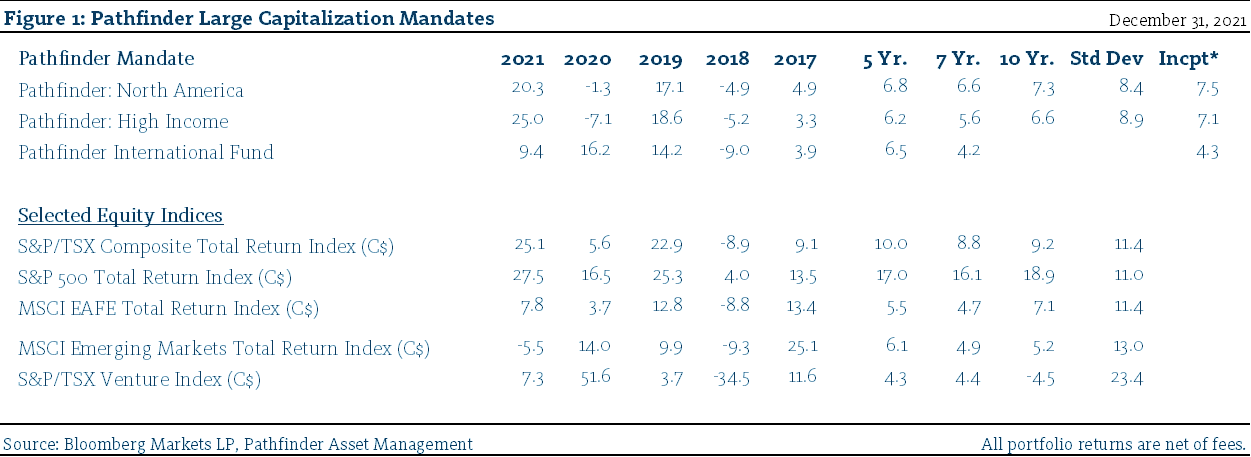
For the calendar year 2021, the North America Equity portfolio returned 20.3% and the High Income portfolio returned 25.0%, while the Pathfinder International Fund returned 9.4% (please see Figure 1). Since our inception in 2011, both of our segregated portfolios have returned 7.5% and 7.1% annualized to December 31, 2021. We have accomplished this while taking less risk vs. equity markets – between three quarters and two thirds of broad market indices, as measured by annualized standard deviation (the monthly fluctuations of your portfolio market value). We have been able to minimize our portfolio standard deviation with two main strategies. First, we invest in companies that are stable cash flow producers and are priced at a discount to their fundamental value. This inherently leads to less volatile portfolios. Second, when the quoted market price of a share of a company that we own rises above what we think will be the best-case scenario for that company, we sell or reduce our investment and allocate that cash to another company that has better value. If we cannot find another company, then we hold the cash in a treasury bill. Holding the cash serves two functions: One, it reduces the risk of the portfolio when we believe prices are too high and two, it provides us an option to buy more shares of good quality companies when those prices are lower. This year, we remain generally satisfied with our investment management execution but again should have been more aggressive in deploying our excess cash.
NORTH AMERICAN EQUITY & HIGH INCOME REVIEW
As we noted in our Portfolio Management Overview released in early January, 2021 was another historic year for global equity markets. This came after three volatile years. Most markets finished the year higher than they started and this was after one of the fastest bull markets in history. We republished the chart below that was released in our Portfolio Management Overview because we found it so striking. The countries are sorted from highest to lowest in terms of return. The green bars show the absolute return where major markets were positive, and the red bars are the negative. The blue group represent the mandates that we focus on at Pathfinder and, as you can see, the vast majority of the world was positive last year. The other item that we noted was that Frontier Markets (markets smaller than Emerging) had a banner year, far outperforming Developed markets. While there are too many to list in this section, we took an average of the top 10 and presented it in the chart below.
Our stock picking generated good results again with the majority of our holdings providing double digit returns and only 4 companies providing negative returns for the year. Our multi-year technology thesis continues to provide gains, as did our Banking thesis. This year, Oil & Gas rebounded, which took us by surprise. While we were underweight in the North American Portfolio, the High Income Portfolio had a large exposure and benefited. This is the major reason for the differences between the two mandate results.
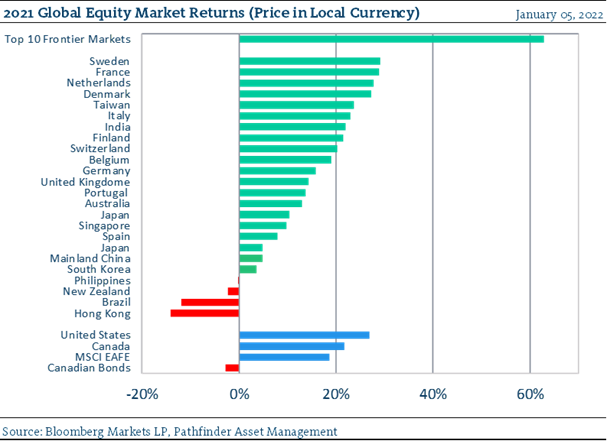
As for individuals companies, Peyto Exploration (CN:PEY) +223.6%, Arc Resources (CN:ARX) +91.7%, Canadian Natural Resources (CN:CNQ) +74.7% and Cameco Corp (CN:CCO) +61.8% were our commodities winners, while Wells Fargo & Co (US:WFC) +59.0%, Bank Of America Corp (US:BAC) +46.8% and the insurance companies were strong. Alphabet Inc (US:GOOG) +65.2%, Microsoft Corp (US:MSFT) +51.2%, Oracle Corp (US:ORCL) +34.8% and Apple Inc (US:AAPL) +33.8% rounded out the technology theme. In our opinion, valuations in the technology space continue to be too high but this year we did not reduce the exposure and continue to watch the sector very closely.
As for our losers, they were pretty sparse but the traditional value stocks were the laggards, as was our cash position (8.7% in North America and 14.8% in High Income). Woodward Inc (US:WWD) -9.9% ,Verizon Communications Inc (US:VZ) -11.6%, Stella-Jones Inc (CN:SJ) -13.5%, AT&T Inc (US:T) -14.5% detracted this year. We already own full weights in Verizon and AT&T as a result of our 5G theme. We sold and added Stella-Jones quite well during the year and it is now an overweight position in the North American portfolio (4.6%).
We often speak with our clients about the difference between trading the market and investing in companies. At Pathfinder, we invest in companies. We aim to buy good quality companies with stable cash flows at a low price. This year, we did much less trading than last year. During the peak of the pandemic, we were able to rotate the portfolio into a number of new companies that offered good value. However, in 2021, we spent the bulk of our time watching managements and evaluating business financial statements in order to track the progression of the companies against our investment thesis. This means that we regularly think about, calculate, and debate the value of companies. We generally agree that companies that offer the best value will, over time, provide the best performance results. We have noticed that, for many years now, companies that have traditionally offered the best value have underperformed. This year, the narrative has started off differently with the positive performance of value stocks taking more financial press headlines. While we are still just a very short time into the new year, we remain confident in the strategy over the long-term and are even more comfortable given that the portfolio is used as an anchor and in the combination with other more aggressive mandates that Pathfinder offers.
PATHFINDER INTERNATIONAL FUND
International markets rebounded somewhat. Developed Europe and Japan had a strong year returning just into the double digits. However, Developed Asia (not including Japan) was down -5.2%. China, in particular, had a difficult year with large and mid-cap companies across China down -22.2%. Hong Kong was down -3.7%. A combination of poor economic expectations and geopolitical issues caused investor sentiment to deteriorate quickly in the second half of 2021. For the year, the Pathfinder International Fund returned 9.4% while international markets as defined by the MSCI EAFE Index were up 7.8% (both in Canadian dollar terms). We have been quite active in the fund again and continue to be very comfortable with its strategy and positioning going forward. Throughout most of 2019, we had established positions in several Chinese companies and we continue that over last year. The fund now has one third of its revenue coming from domestic Chinese businesses. In 2020, we had used short positions and cash taking the fund to approximately 50% cash at the start of the pandemic but, this year, we put most of that capital back to work, adding new companies to the portfolio and increasing our weight in Chinese companies during the recent period of drawdown there. We have not changed our themes that we identified in 2019 and still focus on technology (hardware, ecommerce and industrial electrification), banking and retail in Asia, along with a few commodity special situations. Our best performers were Nvidia Corp (US:NVDA) +125.3%, ASML Holding (NA:ASML) +77.8%, Tokyo Electron (JP:8035) +72.6%, Ivanhoe Mines Ltd (CN:IVN) +50.4% and Abb Ltd (SW:ABBN) +41.2%. This year, China experience the largest draw down since the fund has started and we took the opportunity to add to those positions. While we see the most opportunity from a valuation perspective in China, it is also the place with the worst performers this year: Kingdee International (HK:268) -24.1% Beijing Capital Intl Airport (HK:694) -26.3%, Daifuku Co (JP:6383) -26.3%, Xiaomi Corp (HK:1810) -43.1%, and Alibaba (HK:9988) -48.9%. Much like the North American Portfolio, in hindsight, we could have been much more aggressive about putting our cash reserves back to work but we remain satisfied with the results again this year.
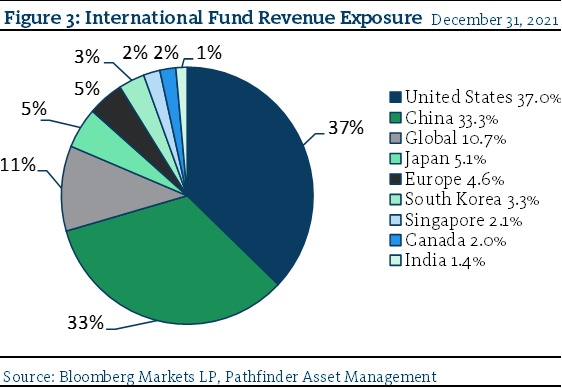
PORTFOLIO STATISTICS
We include Figure 4, which presents the difference between the Pathfinder Large Cap mandates and three large exchange trade funds. We think that this is the most appropriate comparison for our approach. Pathfinder mandates do not look like any common benchmark portfolio. We are more concentrated, less exposed to cyclicals, have better valuation metrics and stronger company fundamentals. Over the years, our allocation to the sectors, geography and cash have changed dramatically. We take a real investment stance, move capital opportunistically and, as a result, expect a more efficient return profile. We cannot guarantee better performance, but we can guarantee that we will be different. In our opinion, this is what most investors are missing in their investment structure.
When we speak with clients and prospects, we often tell them that they have three basic options for the operation of their investment portfolio. 1) “do it yourself” 2) “index” and/or 3) “hire a pro”. There are many “do it yourselfers” and if one is interested, diligent and has the time to give, this is a great way to manage a portfolio. It permits maximum flexibility and is clearly the cheapest. However, individual results can vary, and people are often not objective about evaluating themselves. The second cheapest is passive investing, which is a very valid approach. In this case, a very low-cost ETF and a long-term strategy (i.e. avoid selling in the panic times) guarantees average returns with an essentially institutional type fee. Many people also hire a pro. This unfortunately comes with mixed results. Many professional investor services rely on outsourced money management and, in turn, blend multiple portfolios together, essentially creating a passive portfolio with an active fee. This guarantees that the client earns subpar returns and ultimately leads to a poor client experience.
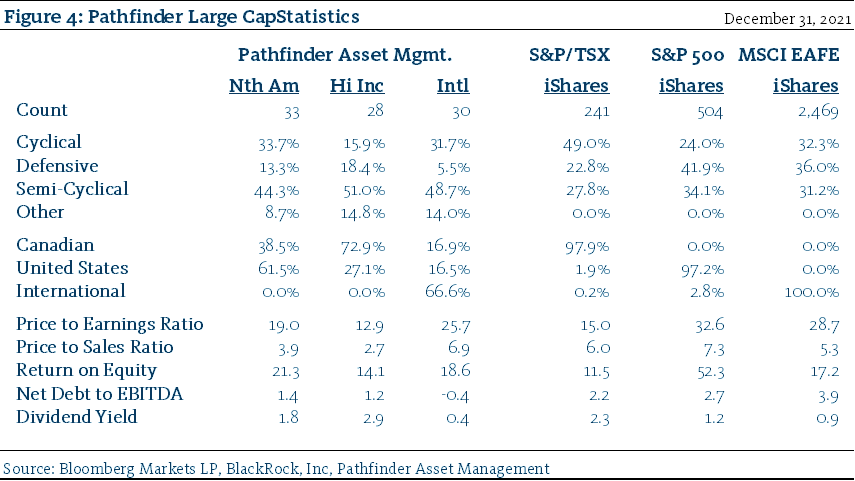
A NOTE ABOUT FIXED INCOME:
We have several clients where we blend in a laddered, investment-grade fixed income portfolio to their equity and fund positions for risk mitigation and capital preservation purposes. At this point in the investment cycle, and given the all-time lows in interest rates, we do not use bonds in our portfolio as an active source of investment return. We remain allocated to short duration bonds, which are a good way to preserve capital and are less sensitive to interest rates. We also believe that credit spreads are too small to warrant investment in most corporate bonds, given the level of absolute debt in financial markets. Consequently, we also tilt the portfolio more towards government bonds. We would need to see mid-to-high single digit bond rates with moderate inflation before we would again consider it as a contributing part of our investment process. Therefore, we prefer to use fixed income as a store of nominal value preferring to focus our portfolios on companies that we believe will have increasing cash flow resulting from increasing interest rates until this environment changes in favor of fixed income.
CURRENT INVESTMENT OUTLOOK
Every year, we like to reread what we wrote the previous year and compare what we thought the coming year would bring to what actually happened. One of the nice things about writing on a regular basis is that we can track how our thought process evolves. This provides us the opportunity for reflection, which is critical for investors. Of course, we did the same thing with last year’s Current Investment Outlook section before we began to write this year’s and we were struck by how quickly inflection points can present themselves. Often when we encounter an inflection point, we must change our investment thesis but other times, doing nothing is the best course of action.
One of the first tings that we noticed this year was the dispersion between the returns of the major equity market sectors. The often quoted sectors are the Unites States, Developed International markets (Europe, Australia, Japan, Singapore & Hong Kong are the majors) and Emerging Markets (Brazil, Russia, India, China and smaller countries like Colombia, Indonesia, Vietnam, and Mexico). The United States was the best performing of the three after government stimulus took markets to new heights. The S&P 500 was up 28.7% in US$ terms. International markets were up 8.8% (also US$) and Emerging Markets actually lost -4.8% last year. This does make sense as economic opportunities in the United States were viewed by investors more favorably. Capital flowed into that market at the expense of other markets and asset classes, including small countries. The narrative has now changed somewhat given the potential increase in administrated interest rates in the US. The consensus view of the US dollar is now weaker in favour of countries that would benefit from a weaker dollar as trading partners.
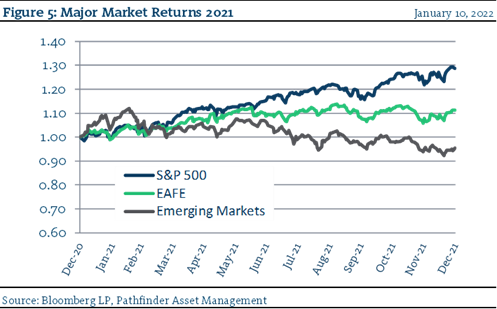
While the paths of economies in different parts of the world are important, we also need to consider the generational change in inflation. It has been decades since investors have been concerned with inflation and its direct link to interest rates, as well as the impact on profit margins for the various companies that we own in the portfolios. This past week, inflation in the US reached 7.0%. To put this in context, the Federal Open Market Committee (FOMC) of the US Federal Reserve targets 2% as its long run goal and we have not seen this level of inflation in the US since the spring of 1982. The FOMC previously stated that it expected inflation to be transitory, and more related to supply chain and labour market disruptions than an increase in structural inflation. It also said that it would permit inflation to “run hot” over its 2% target for a period of time such that the average would be 2%, given how long inflation had stayed below its target prior to the pandemic. More recently, guidance and consensus say that the FOMC will have to back away from this stance and potentially raise administered rates 4-5 times next year. This is a material change.
We find ourselves again faced with a very different outlook than we had one year ago. Again, this year, we break the discussion into two separate, yet equally important parts. The economy and the financial markets (which regular readers will know are not the same thing).
Economy: We present the same charts as last year but with the data updated to the end of 2021. We have recently gone through the highest velocity drop and recovery in our economic history. When we wrote this report last year, we were not sure if we had recovered from recession. With the benefit of hindsight, it was officially declared over at the end of April 2020 with the economic peak in the fall of 2019. That means the recession lasted only 4 months. This is essentially unheard of as we officially need 2 full quarters of GDP contraction to make it official. While the definition did not fit technically, the world was obviously in distress, but it was very short due to quick coordinated government response.
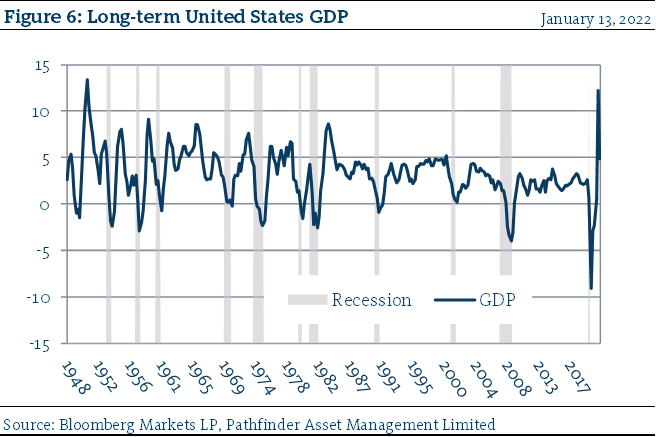
It now seems that globally we have come out the other side from an economic perspective. Most economies have somewhat stabilized. Figure 7 presents management expectations as measured by Purchasing Managers Indices, which have been somewhat more volatile after the recession than before, but are still positive. This makes intuitive sense. These data are close to real time business expectations. As you can see, for the most part, global managers of both manufacturing and service companies, on average, expect future business conditions to expand in a similar manner as before the pandemic (i.e. all countries surveys are above 50).
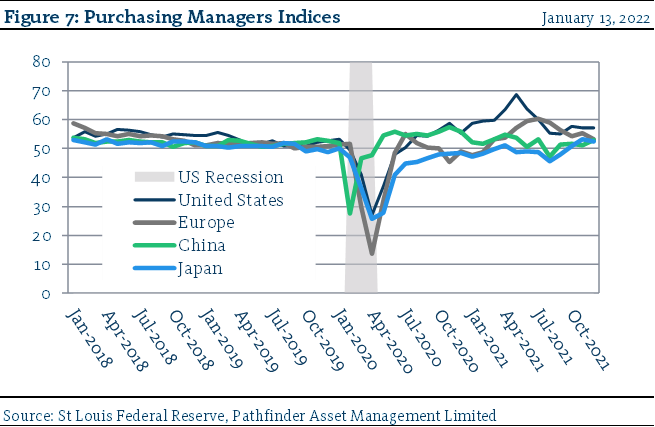
Retail Sales Growth also has bounced back (Figure 8). This is constructive, particularly in China, which has been dealing with pandemic mitigation measures in a much more strict way than the rest of the world.
While the two charts above show that economic conditions have reverted, it is also interesting to note the increased volatility of the data after the recession. We also note from the data and geopolitical headlines more separation between China and rest of the world. This is a new dynamic that presents both opportunities and great risk, depending on how governments navigate the change. Add the new inflation dynamic and there are many paths that the recovery can take.
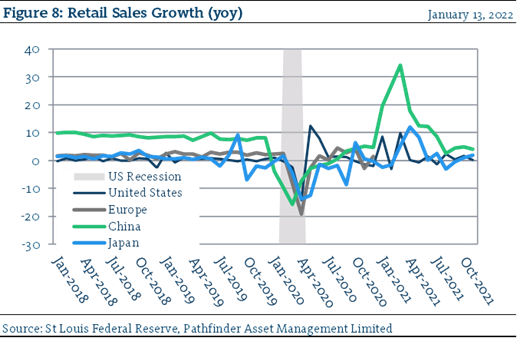
Market: While we noted on the previous page that the global economy remains fragile, given inflation and geopolitical threats, the market has continued to reach new highs, pushing valuations into historic ranges.
Please keep in mind what we noted above: The economy and the stock market are not the same thing. Our collective economies were fragile and have only recently recovered; however, financial markets are as high as they have ever been and valuations continue to be stretched. We published The Buffett Valuation (broad US stock market capitalization divided by the US GDP) last year in Figure 9 and have decided to update it again for this year. It was at an all-time high last year and increased again this year. While this is probably not a data point that one can trade off of, it does provide a good indication of the general direction of valuations and should be taken as a cautionary signal.
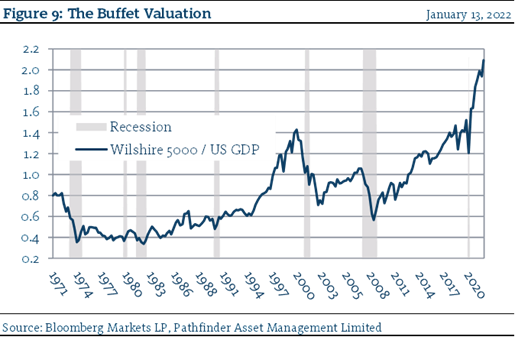
We also published Price Earnings multiples over time for US and International stocks in Figure 10. Prices were high last year and remain so again. While growth has bounced back, prices have also continued higher. The exception is International stocks, which after the recent drawdown in Asia, remain one of the areas of the stock market that still continues to offer real value, in our opinion.
We also note the concentration of the S&P 500 as another point with respect to risk. The total market cap of the S&P 500 started the year at US$33.16 Trillion. It ended the year at $42.07 Trillion. These are incredible numbers!! The 5 largest stocks in the S&P 500 are Apple, Microsoft, Google, Tesla and Meta Platforms (formerly Facebook). The year started with these five mega-cap companies collectively worth $6.5 Trillion or 20% of the of the entire index. At the end of the year, they were worth $8.7 Trillion. You might have recently read in the news that Apple passed $3T in market cap, but both Microsoft and Google also passed through $2T individually. We noted earlier that the whole index returned +28.7% last year. These 5 companies returned +33.2% collectively which accounted for 7% of the total return. The rest of the 495 stocks returned +25.2%.
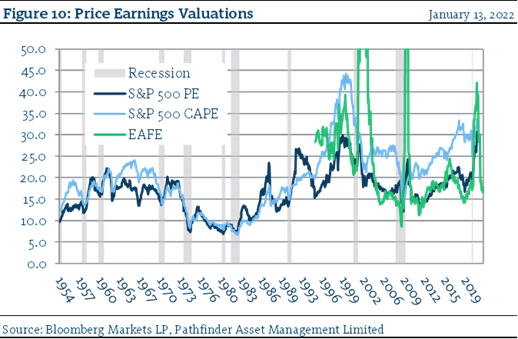
Conclusion: We will continue to look for good quality, mispriced assets that provide fair investment opportunity. The combination of high valuations and the potential for excessive inflation are real risks to both equity and fixed income assets. While we focus our efforts on companies that can provide protection in this type of environment, we should expect continued volatility in the short and medium terms. Over the long term, our investment view remains unchanged.
CORE:100
We maintain a list of what we consider to be world class companies in all industries and across all major geographic areas. We regularly screen global stocks, based on our valuation framework, for new names that we can consider for addition to our universe of coverage. We focus on well managed, fundamentally strong firms that consistently generate and grow cash flow. We also expect strong quality management teams to reinvest that cash flow in improving their businesses. These firms have defensible advantages and ideally return any excess capital to their owners (i.e. us!!) in a rational, economic and consistent manner. The list is then filtered for qualitative factors including sector balance, general economic trends and changes in technology (even the best quality “betaMax producer” will not be a good investment!!) and we generate buy and sell targets for each company in the universe. This is what drives our portfolio investment decisions. Our thesis is that these companies should do better than the general market over the long-term and, more importantly, they should outperform during the regular periods of distress that we seem to have every 7-10 years. If we are buying from a list of “the best companies in the world” and buying at a discount, then the portfolios that we construct should do better on a risk-adjusted basis as well.
We have expanded past our 100 names in the Core 100 as we find new additions and our investment thesis evolves to include more international companies. Generally, this is a slow-moving process that does not change significantly from year-to-year, but some evolution is healthy given global changes and the ongoing development of our investment view and process. In 2020 we removed 20 companies from the North American universe and 1 from Europe, mostly because of M&A activity and business deterioration (i.e. potential value traps). Our screening process identified 60+ companies for consideration and after reviewing each firm, we decided to add 9 to North American and 15 to the International universes. This year, again, we identified dozens of potential companies for inclusion but added only 10 while dropping 16 for a net reduction of 6 companies. We expect the number of companies that we follow in detail to increase towards 150 over time and hope to find more international additions than North American as that is where we find most of the economic leadership developing. Figure 11 presents our current characteristics against large exchange-traded fund portfolios. As you can see, our metrics tend to be more value and economic return focused with less leverage than the board markets.
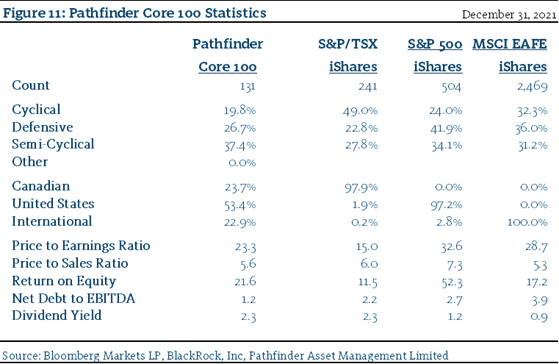
We are always looking to improve the quality of the companies that we consider for the portfolios. Each day, we run the screen that identifies new companies that fit the broad parameters of what we consider to be a “good” company. The list is continually expanding and over the coming year it will be reviewed to determine if there is a potential fit for the Core 100.
National Instrument 31-103 requires registered firms to disclose information that a reasonable investor would expect to know, including any material conflicts with the firm or its representatives. Doug Johnson and/or Pathfinder Asset Management Limited are an insider of companies periodically mentioned in this report. Please visit www.paml.ca for full disclosures.
*All returns are time weighted and net of investment management fees. Returns from the Pathfinder Partners’ Fund and Partners’ Real Return Plus Fund are presented based on the masters series of each fund. The Pathfinder Core: Equity Portfolio and The Pathfinder Core: High Income Portfolio are live accounts. These are actual accounts owned by the Pathfinder Chairman (Equity) and client (High Income) which contain no legacy positions, cash flows or other Pathfinder investment mandates or products. Monthly inception dates for each fund and portfolio are as follows: Pathfinder Core: Equity Portfolio (January 2011), Pathfinder Core: High Income Portfolio (October 2012) Partners’ Fund (April 2011), Partners’ Real Return Plus Fund (April, 2013), and Partners’ Core Plus Fund (November 2014).
Pathfinder Asset Management Limited (PAML) and its affiliates may collectively beneficially own in excess of 10% of one or more classes of the issued and outstanding equity securities mentioned in this newsletter. This publication is intended only to convey information. It is not to be construed as an investment guide or as an offer or solicitation of an offer to buy or sell any of the securities mentioned in it. The author has taken all usual and reasonable precautions to determine that the information contained in this publication has been obtained from sources believed to be reliable and that the procedures used to summarize and analyze such information are based on approved practices and principles in the investment industry. However, the market forces underlying investment value are subject to sudden and dramatic changes and data availability varies from one moment to the next. Consequently, neither the author nor PAML can make any warranty as to the accuracy or completeness of information, analysis or views contained in this publication or their usefulness or suitability in any particular circumstance. You should not undertake any investment or portfolio assessment or other transaction on the basis of this publication, but should first consult your portfolio manager, who can assess all relevant particulars of any proposed investment or transaction. PAML and the author accept no liability of any kind whatsoever or any damages or losses incurred by you as a result of reliance upon or use of this publication.